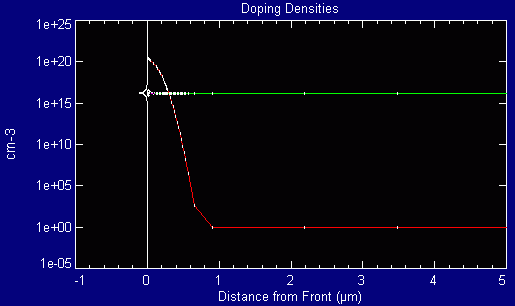
- #How to plot my graph using pc1d code
- #How to plot my graph using pc1d download
Let’s go through some simple examples to illustrate these two concepts. Thus, the arguments of ggplot() can be also left blank.

Within this function’s arguments, you would specify the parameters specific to this aesthetic/layer (dataset, x and y variables, groupings, etc.). where each of these types has their own function you would call in place of aesthetic(…). Some examples include a scatterplot, smoothed line(s) of best fit, box and whisker, etc. The argument aesthetic(…) is replaced with the name of the function corresponding to the general way you would like your data to be shown. Where the function ggplot2() is where you can specify the dataset, variables (x-axis and y-axis), groupings, colors, etc.to be used for all relevant layers in the plot.
#How to plot my graph using pc1d code
The general structure of your ggplot code is the following: You can think this as different layers placed on the same space which when placed on top of one another compose your plot. The guiding principle behind ggplot2 is that you build your plot from its foundational components (what dataset you are using, a template, etc.) to its more specific components (title, legend, etc.) and connect these components together using +. In dplyr, this operator was the pipe %>% and in ggplot this operator is +. Like dplyr discussed in the previous chapter, ggplot2 is a set of new functions which expand R’s capabilities along with an operator that allows you to connect these function together to create very concise code. Ggplot2 is a package for R and needs to be downloaded and installed once, and then loaded everytime you use R.
11.3.1 Setting the Seed: Reproducibility in Simulation Studies. 11.2.1 Example: Regression Analysis as a Function Call. 11.1.1 Example 1: Running many regression models. 9.4 Creating your document from the R Markdown file. 9.3 Understanding the R Markdown editor.  9 Documenting your results with R Markdown. 8.4.3 Interpreting results: time dependent covariates. 8.4.2 Example: Mullen composite and Visit. 8.3.3 Example 2: Categorical Covariates. 8.2.5 Example 2: Categorical predictors. 7.2.2 Accounting for estimation variance and hypothesis testing. 7.2.1 Parameter Estimation: Mean, Median, tutorial, Quantiles. 6.2 Creating Basic Tables: table() and xtabs(). 4.2.6 Editing factor variables: recode() and relevel(). 4.2.3 Spread, Gather, Separate and Unite. 2.3 R and RStudio: What is the difference?. With this, we will have a ‘Format Series’ dialog box. Now right-click on any data point or dot) -> Select ‘Format data Series’:. This will finally generate the below scatter plot:. Now in this ‘Edit Series’ window, select ‘Salary’ range under ‘Series X values’:. With this, we will have a popup window for the edit series:. Now in the section ‘Legend Entries’, select ‘Expenditure’ in this window, and choose ‘Edit’ :. In the resulting window, select ‘Salary’ in the section: ‘Legend Entries’, and then select‘Remove’. On doing this, we will get a popup window:. Now right click on the scatter lot -> Click on ‘Select Data’:. Now the chart title can be changed by double-clicking on it and then renaming it: With this, we will have the data plotted as follows:. Select the dataset and click on the ‘Insert’ tab. Now in order to create a scatter plot for this data in Excel, the following steps can be used: We have the following data of monthly salaries and expenditures in an Excel file: Let us suppose there is an interrelated dataset where we have some people’s monthly salaries and their expenditures. Now the relation between salary and expenditure can be plotted in Excel with the help of a scatter plot.
9 Documenting your results with R Markdown. 8.4.3 Interpreting results: time dependent covariates. 8.4.2 Example: Mullen composite and Visit. 8.3.3 Example 2: Categorical Covariates. 8.2.5 Example 2: Categorical predictors. 7.2.2 Accounting for estimation variance and hypothesis testing. 7.2.1 Parameter Estimation: Mean, Median, tutorial, Quantiles. 6.2 Creating Basic Tables: table() and xtabs(). 4.2.6 Editing factor variables: recode() and relevel(). 4.2.3 Spread, Gather, Separate and Unite. 2.3 R and RStudio: What is the difference?. With this, we will have a ‘Format Series’ dialog box. Now right-click on any data point or dot) -> Select ‘Format data Series’:. This will finally generate the below scatter plot:. Now in this ‘Edit Series’ window, select ‘Salary’ range under ‘Series X values’:. With this, we will have a popup window for the edit series:. Now in the section ‘Legend Entries’, select ‘Expenditure’ in this window, and choose ‘Edit’ :. In the resulting window, select ‘Salary’ in the section: ‘Legend Entries’, and then select‘Remove’. On doing this, we will get a popup window:. Now right click on the scatter lot -> Click on ‘Select Data’:. Now the chart title can be changed by double-clicking on it and then renaming it: With this, we will have the data plotted as follows:. Select the dataset and click on the ‘Insert’ tab. Now in order to create a scatter plot for this data in Excel, the following steps can be used: We have the following data of monthly salaries and expenditures in an Excel file: Let us suppose there is an interrelated dataset where we have some people’s monthly salaries and their expenditures. Now the relation between salary and expenditure can be plotted in Excel with the help of a scatter plot. #How to plot my graph using pc1d download
You can download this Plots Excel Template here – Plots Excel Template Example #1 – Simple Scatter Plot Lets us discuss the examples of Plots in Excel.
The correlation between two datasets is negative if the data points’ pattern on the plot goes from upper left to lower right,. The correlation between two datasets is positive If the data points’ pattern on the plot goes from lower left to upper right. The correlation between two variables is said to be strong if the data points are concentrated around a line on the plot. If the data points on a plot are spread widely on the plane, then it implies that the correlation between two variables is weak. If the data points on the plot look like they are randomly scattered, then it implies that there is no correlation between the two variables. We can interpret the scatter plots in the following manner: Scatter with straight lines and markers. 

In MS Excel, some layouts that are available for scatter plot are: Scatter plots use the Cartesian axes or coordinates so as to display the two data sets’ values. Excel functions, formula, charts, formatting creating excel dashboard & others








 0 kommentar(er)
0 kommentar(er)
